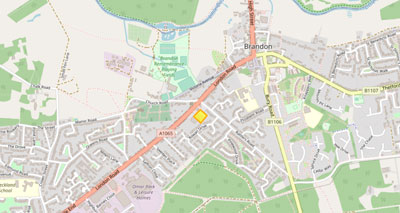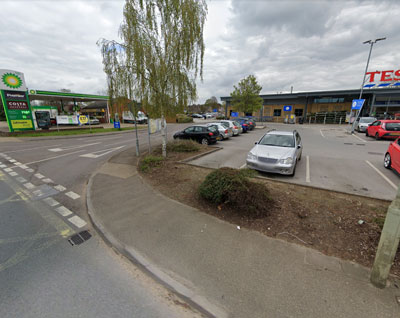Steam Brickworks at Brandon
Very little seems to be written about this brickworks, except that it is listed in C J Pankhurst's appendix to the British Brick Society newsletter in 1988 under the exotic name of Spartan Brickworks.
Mr Pankhurst lists its correct map reference, but attributes it to White Lion Street, Brandon, which is now called George Street. This may have been the manager's residential address, rather than a brickworks.
However, it is now believed that most of Pankhurst's conclusions about this brickworks were erronious, apart from its existence at this location.
It seems that it was never the Spartan Brickworks, but was known as the Steam Brick Company, owned by Baron Victor Barreto of the Hall, Brandon Park. (Although he also had residences in London and Ryburgh.)
In the 1899 (RG13/1899) (gbc_1901_1896-1899_0650) census at the Hall in Brandon Park, Victor Barreto (Baron) aged 32, was recorded as "Living on his own means, Magistrate and Brick Manufacturer. Employer. Born in Middlesex London.
Living with his wife Ethel Barreto (Baroness), and five servants.
On the 8th March 1902 the Norfolk News reported that ‘an important sale’ of farming stock took place on the Brandon Park estate on Feb. 27th. The items sold included an uninteresting mixture of farm implements - drills reaper, rollers - as well as horses, carts and several hundred pheasant coops.
The interesting part concerned the sale of 455,000 bricks at the brickworks on the Rattler’s Road and London Road corner. This is now the site of Tesco supermarket.
The bricks were those made by a new Steaming process: the clay was replaced by sand and lime and the bricks were then hardened by steam.
The Baron Barreto, who owned the Brickworks held a patent for ovens ‘made in the form of an arch or tunnel of metal plates lined with brickwork, through which trucks carrying the bricks to be treated are run on rails. Steam is applied through perforated pipes.’
Barreto also held a patent for " an improved process for the dry slaking of lime, and apparatus therefor, for the term of fourteen years from the date of the said Letters Patent, and which Letters Patent have been assigned to and are now held by Henry Ernest Victor, Baron de Barreto, of Sennowe Park, Ryburgh, in the county of Norfolk."
Buyers came from all over East Anglia for the sale: a Mr Skipper of Norwich bought bricks for the new Norwich Union fire office, Waters & Son and Minns of Watton and J Sizer and Parson & son of Lakenheath all bought bricks The average price was between 16 & 17shillings (about 80 pence) per 1000.
After the sale of the bricks the auctioneers moved to the Ram Hotel, where freehold property was auctioned off in 15 Lots. Amongst the lots were several along London Road between the Rattler’s Road corner, ie the Brickworks, and the Pit (now Sandgalls).
Albert Carter paid £120 for Lot 4 described as a building site measuring just over 3 ½ acres about 100yards from the factory. He had also bought some bricks and within the year had used them to build Oak Terrace.
There are several other examples of the distinctive gritty grey Brandon bricks around the town often with a band of reddish bricks running across the front wall between the two storeys. If you look out for them you will spot a number of similar buildings around the town, including a terrace on Thetford Road, which was also owned by Carter.



